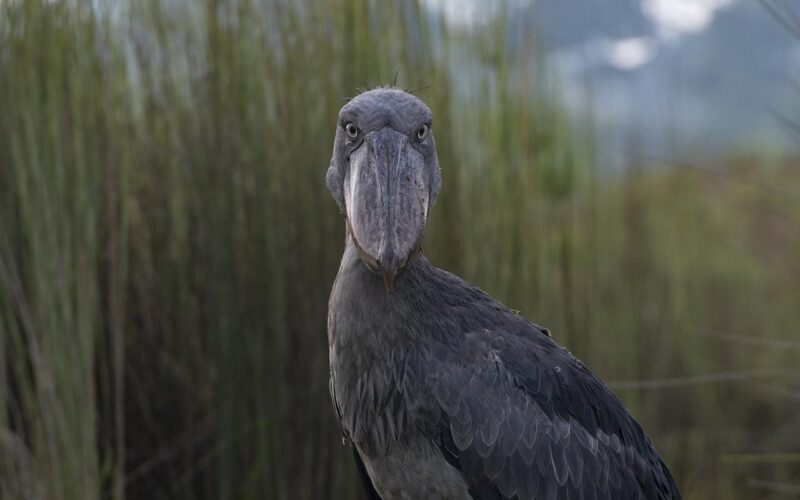Mabamba wetlands is a home to Africa’s most unique bird – the shoebill. Extending over 100 sq km from the shallow marshy bay on the northern shores of Lake Victoria near Entebbe, Mabamba wetlands is the most convenient and reliable birding hotspot to encounter the highly sought-after Shoebill in its natural habitat. The wetland is a major breeding stronghold for the critically endangered Shoebill and currently recognized as both an Important Bird Area and a Ramsar site.
Mabamba wetland is a community-ran initiative that protects this fragile habitat not only for the Shoebill that breed here but the entire eco-system that include other aquatic species. A birding outing to Mabamba is not limited to the marsh only but extends along cultivated wetland edges where the bird-rich agricultural lands and tropical forests patches offer a rewarding birding experience.

Shoebill Birding at Mabamba Wetlands
Mabamba wetland is often visited as a day-tour by visiting birdwatchers, photographers and generalists where the major highlight is to encounter the prehistoric Shoebill that occur here. At about 1m tall, the Shoebill is neither a stork or an eagle though it shares a few common attributes but recent studies have placed it as a sole member of Balaenicipitidae, a monotypic African family. A resident of secluded and permanent wetlands, the Shoebill is a slow breeder, classified as vulnerable on IUCN red-list and continues to face challenges from habitat conversion for agriculture, pet traders and competition from fishermen.
Shoebill birding trips at Mabamba are led by community guides that use smaller motorized canoes to access the interior of this vast marsh across a maze of channels to where the Shoebill feeds. The shoebill is a near-solitary species encountered alone or only with juveniles/young. In this vast marsh the Shoebill is a top predator feeding mainly on lungfish, catfish and other crustaceans that occur here.
Its unique hunting style of motionless stalking has earned the Shoebill as a “statue” name – where they have been observed stalking their prey motionless for a long time and when prey comes in range, striking with lightning speed. Even then, the Shoebill has about 50% of hunting success.
Other Bird Highlights at Mabamba Wetlands
Mabamba wetlands lie entirely in L. Victoria biome where vegetation types range from wetlands/marshes, open water and sedges hosting a variety of biome restricted bird specialists that birdwatchers look out for in this unique to this habitat. These biome restricted species include; the Papyrus Gonolek, White-winged Swamp Warbler, Northern Brown-throated Weaver, African Pygmy Goose, Carruthers’s Cisticola, Blue-breasted Bee-eater, Blue-headed Coucal, Greater Swamp Warbler, Lesser Jacana and more.
Resident wetland specialists include Malachite and Pied Kingfishers, Winding Cisticola, African Jacana, Long-toed Lapwing, Cape Wagtail, Fan-tailed Widow, Red-chested Sunbird, Common and Lesser Moorhen, gigantic Spur-winged Goose, Purple Swamphen, Yellow-billed Duck, White-faced and Fulvous Whistling Ducks, Saddle-billed Stork, Purple and Grey Herons.
The marsh is utilized by Palearctic migrants that include millions of White -winged Black Terns, Common-winged Plover but other African migrants pass through wonder through including the Olive Bee-eaters and the rare Blue-swallow from south. Raptors include African Marsh Harrier, Black Kite, African Fish Eagle, White backed Night-Heron and the seasonal Osprey.
On a full-day birding tour, exploring the agricultural lands and forest patches along the marsh edges produce a superb checklist among them; Great-blue and Ross’s Turaco, Lizard Buzzard, Woodland Kingfisher, Crowned Hornbill, Red-eyed Dove, Eastern Plantain-eater, Black-headed, Slender-billed, Viellot’s and Village Weaver among other.
Getting to Mabamba Wetlands Birding area
The fishing village of Mabamba lies some 40km or 2-hrs drive west of Entebbe following a well maintained murram road. Birding visitors to Mabamba wetlands are required to arrive at Mabamba fishing landing site that host a community office where the guides and canoes can be obtained for the activities. An shorter alternative route uses a scheduled ferry crossing at Nakiwogo landing at Buwaya village from where the Mabamba fishing village lies some 15-km away.
And with even shorter time on your hands, one can hire out a motorized canoe at Nakiwongo landing site where for 45-mins across the L. Victoria channel, you will arrive at Mabamba marsh edges to be picked up into a smaller canoe to further explore this wetland.
